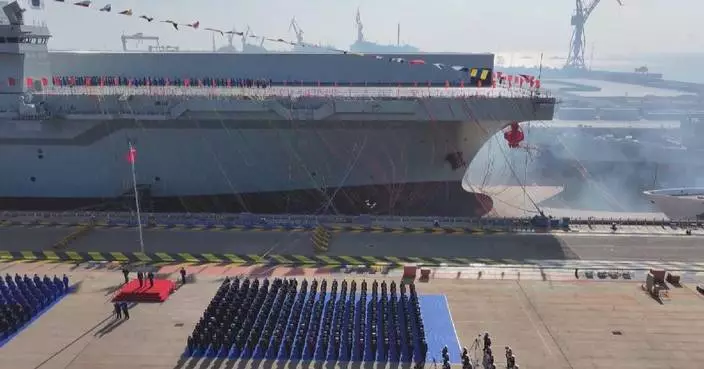China's Shanghai-Suzhou-Huzhou high-speed railway officially entered service on Thursday,linking the financial hub of Shanghai with the historic cities of Suzhou and Huzhou in a major boost to regional connectivity.
The high-speed railway has a designed speed of 350 km per hour and spans 164 km, connecting Shanghai Hongqiao Station with Suzhou City in Jiangsu Province and Huzhou City in Zhejiang Province. The railway has eight stations, providing convenient access to major cities and towns along the route.
This is the first high-speed railway connecting the three major economic hubs of Jiangsu, Zhejiang and Shanghai in the Yangtze River Delta, according to Chen Guoquan, the railway project designer from China Railway Construction Corporation.
Residents are excited about the operation as the new high-speed railway is expected to significantly reduce travel times and improve connectivity between the three cities.
"We're in Huzhou city. It's so convenient for us to travel by high-speed train to Shanghai. It's good for people like us, so I'm very delighted," said a passenger.
"We have several places to visit. All the four people are excited. They all arrived early," said another passenger.
Before this new train service, the journey between Huzhou and Shanghai took about two hours. Now, it only takes around 50 minutes.
With the new railway, the operating length of the railway network in the Yangtze River Delta region has surpassed 15,000 km, over half of which is high-speed rail.
Along the railway, high-end industries are expected to cluster, further accelerating the high-quality development of the economic belt, according to Zhang Zhipeng, associate professor at Shanghai Jiao Tong University.

Shanghai-Suzhou-Huzhou high-speed rail line starts operation
The Hong Kong Garrison of the Chinese People's Liberation Army (PLA) on Thursday conducted a joint patrol participated by its army, naval and air force units, focusing on enhancing the troops' combat, commanding and coordination capabilities under emergency and special circumstances.
The joint patrol involved multiple services and arms such as army infantries, naval vessels, and army helicopters, focusing on air and sea patrol, search and seizure, joint control of sea areas, and emergency rescue and repair.
At 9:00 in the morning, naval vessels at the Chinese PLA Hong Kong Garrison's Ngong Shuen Chau Barracks made emergency preparations, deported from the military port to the target sea area. Two army helicopters of the air force flew to the mission area to support the naval fleet in the joint air-sea patrols, management and control.
After the troops arrived at the target sea area, the helicopters found a "suspicious vessel" there and rapidly flew over it to issue a warning, stopped it and then led the naval vessels to intercept the ship. A special squad on the naval vessel then boarded the ship for inspection and arrested suspects.
"With the help of radar, optoelectronic devices, and automatic identification system, the naval vessels and helicopters coordinated closely to identify, intercept and search the target ship. The drill has tested the troops' comprehensive discrimination ability of sea and air situations and their emergency-handling capability."
Meanwhile, in Shek Kong Barracks, army infantries coordinated with the helicopters to conduct maritime security patrol on important target in the mission area.
"The joint patrol was set in an actual combating scenario. We organized emergency dispatch of troops of multiple services in joint formation and multiple locations, highlighting practical content such as rapid joint planning and command of drills, sea and air patrols, inspections and arrests, joint management and control of sea areas, and emergency rescue and repair in a coherent manner. The test in high-intensity confrontation has improved the combat capabilities of the garrison troops in responding to emergencies and performing diversified military tasks," said Zhao Long, another soldier from the PLA Hong Kong Garrison.
During the joint patrol, the participating troops strictly followed the laws and regulations of the Hong Kong Special Administrative Region ( HKSAR) on the management of roads, waterways and aviation, and had notified relevant departments of the HKSAR government in advance.

PLA Hong Kong Garrison organizes fourth joint patrol in 2024










